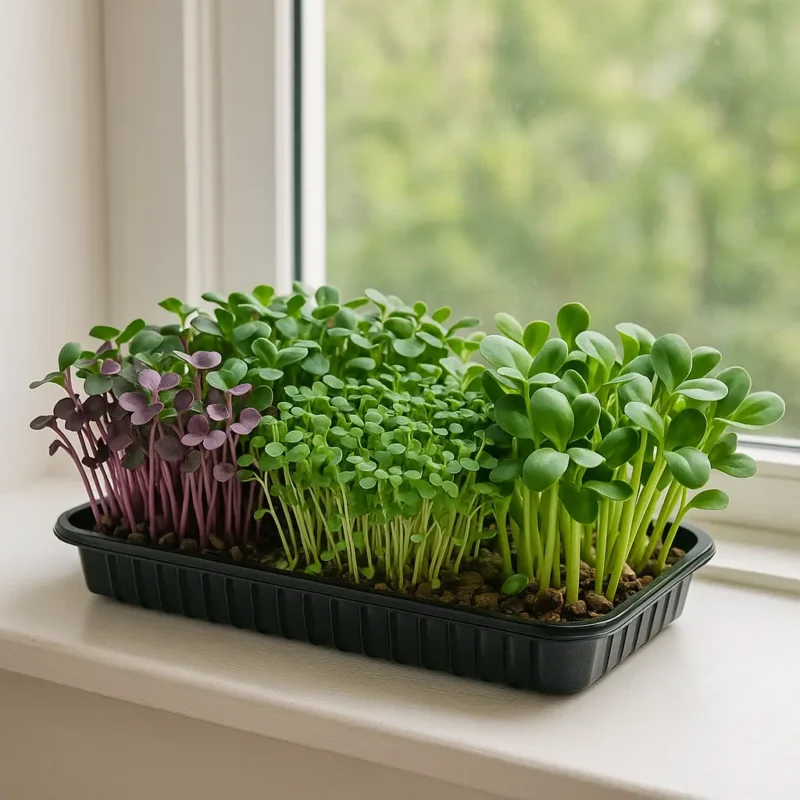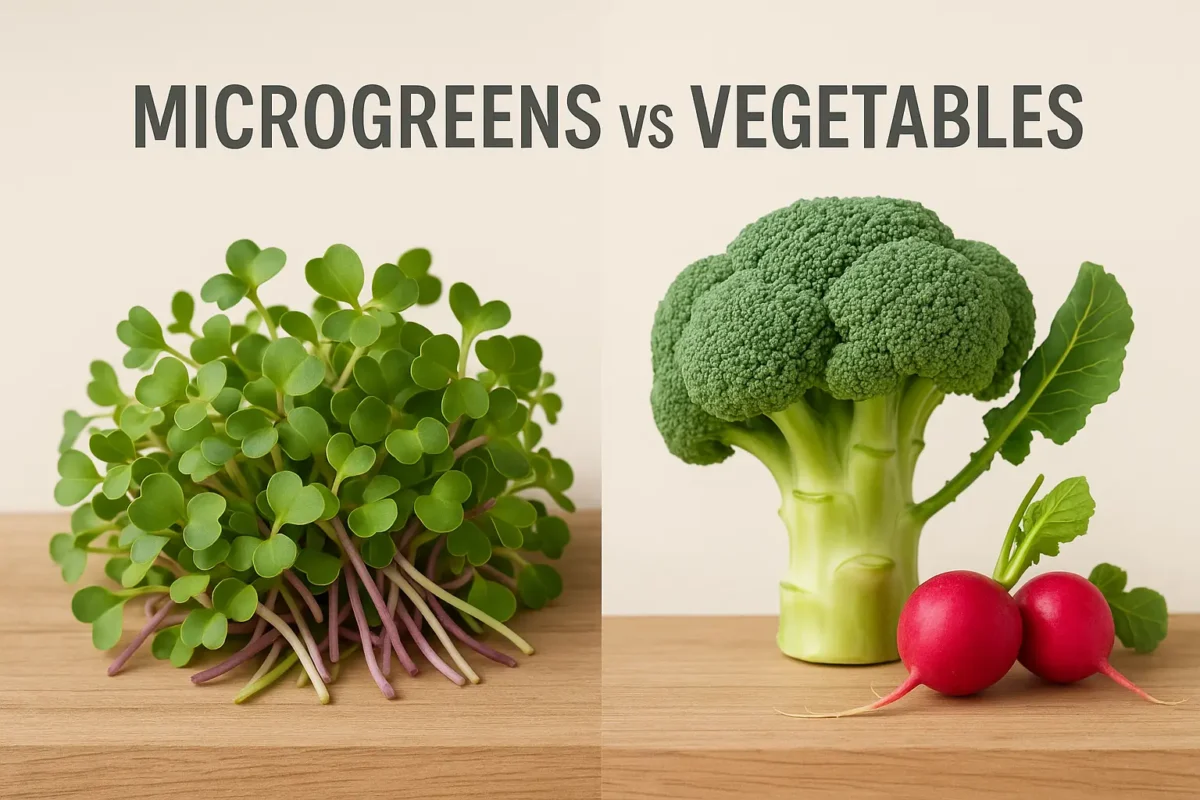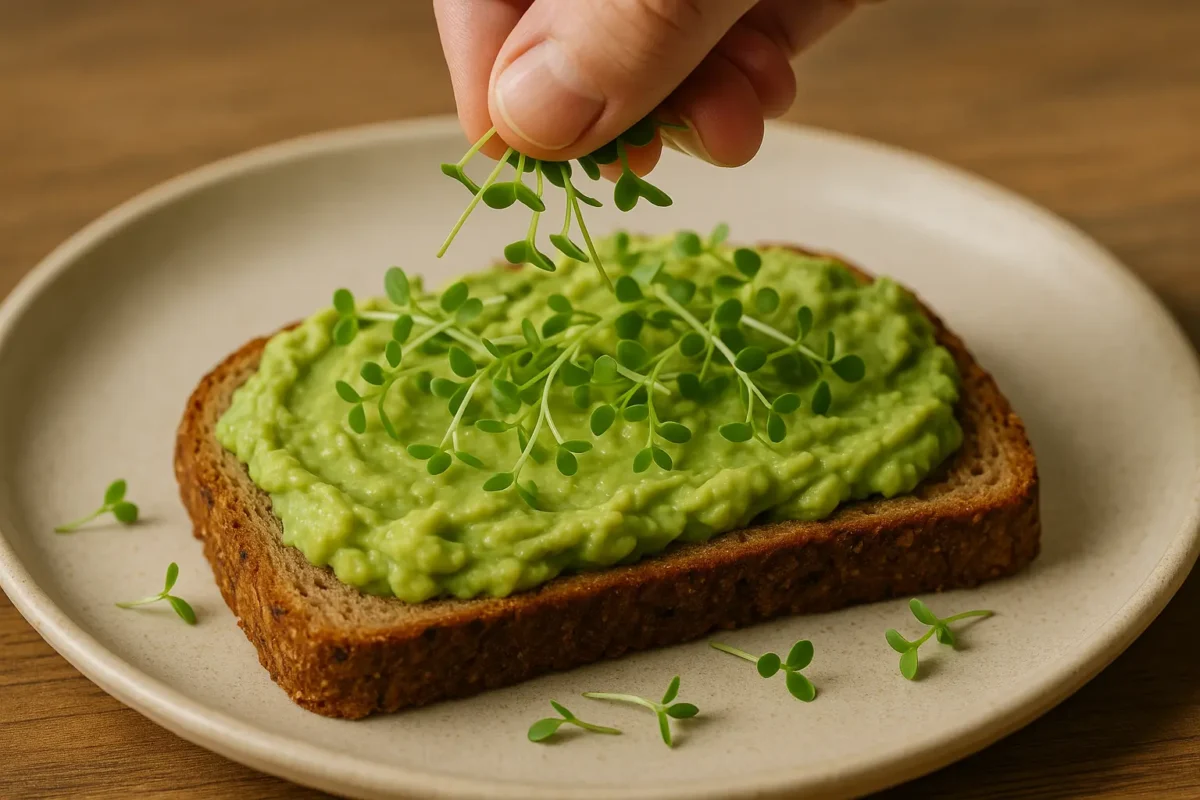“Small but mighty” — this phrase has never been truer than when describing microgreens. But in the debate of microgreens vs vegetables, do these tiny greens genuinely outshine their mature counterparts when it comes to nutrition? Let’s find out.
What Are Microgreens?
Microgreens are the young seedlings of edible vegetables and herbs, typically harvested just 7–21 days after germination, when the first set of true leaves appears. Unlike sprouts, which are eaten root, seed, and shoot, microgreens are clipped just above the soil line and consist only of the stem and leaves. This distinction plays a key role in the microgreens vs vegetables conversation, especially when comparing nutritional concentration and how they’re consumed.
Microgreens come in a wide variety of types—from broccoli, radish, and sunflower to coriander, pea shoots, and basil. Thanks to their delicate flavour, vibrant appearance, and powerful nutritional content, they’re increasingly being used in home kitchens, cafés, and high-end restaurants alike. When comparing microgreens vs vegetables, their versatility and visual appeal make them a popular choice not just for chefs, but also for health-conscious consumers.

Why Compare Microgreens to Vegetables?
You might ask — why not just eat the fully grown version of the plant?
The answer lies in three key factors:
- Nutritional density
- Convenience and speed of growth
- Taste and culinary versatility
Microgreens require less time to grow, take up less space, and often pack a more concentrated nutrient punch — but how much more?
The Nutritional Science Behind Microgreens
Multiple studies, including research conducted by the University of Maryland and the USDA, have found that microgreens can contain significantly higher nutrient concentrations compared to their mature plant equivalents.
Vitamins and Antioxidants
In one landmark 2012 study, researchers tested 25 commercially available microgreens and found that they often contained 4 to 40 times more nutrients than their mature counterparts. This finding highlights a major distinction in the microgreens vs vegetables debate, particularly when it comes to nutrient density. These nutrients included:
- Vitamin C – Boosts immunity and acts as a powerful antioxidant
- Vitamin E – Essential for skin and cell health
- Vitamin K – Vital for bone health and blood clotting
- Beta-carotene – The precursor to vitamin A, important for vision and immune function
- Lutein and Zeaxanthin – Protect eye health

Minerals and Phytochemicals
Microgreens also tend to have higher levels of essential minerals like potassium, iron, zinc, magnesium, and copper. Additionally, they’re rich in polyphenols and other phytochemicals, which are linked to reduced risks of chronic diseases such as heart disease, diabetes, and certain cancers. These nutrient advantages are central to the microgreens vs vegetables comparison, especially for those seeking functional foods with maximum health impact.
Example: Red Cabbage Microgreens
Red cabbage microgreens, for example, contain 6 times more vitamin C and 69 times more vitamin K than the mature cabbage — making them a fantastic choice for boosting nutrient intake without bulk.
Why Are Microgreens So Nutrient Dense?
Plants concentrate nutrients early in their development to fuel rapid growth. Since microgreens are harvested shortly after germination, they retain much of this nutrient density. Additionally, because you’re eating the seedling just before it begins to allocate resources to support a larger plant, you’re getting a dense package of nutritional compounds in a very small space. This early-stage concentration is a key factor in the microgreens vs vegetables debate, helping explain why microgreens often contain significantly more nutrients per gram.
How Microgreens Compare to Full Vegetables
Let’s compare a few examples side by side:
| Microgreen Type | Key Nutrients | Compared to Mature Vegetable |
| Broccoli | Vitamins C, E, K | Up to 40x more vitamin E |
| Red Cabbage | Vitamin K, C, Anthocyanins | 6x Vitamin C, 69x Vitamin K |
| Cilantro | Lutein, Beta-carotene | Up to 3x antioxidants |
| Radish | Polyphenols | More pungent and potent |

Do Microgreens Replace Vegetables?
While microgreens offer an incredible nutritional boost, they shouldn’t replace vegetables altogether. Here’s why:
1. Fibre Content
Microgreens have minimal fibre because they’re harvested young. Full-grown vegetables provide the bulk needed for healthy digestion and blood sugar regulation.
2. Volume Needed
To match the fibre and calorie content of, say, a full head of broccoli, you’d need a large quantity of microgreens — not always practical (or affordable) to consume.
3. Culinary Applications
Mature vegetables are ideal for roasting, steaming, and bulk meals. Microgreens shine as garnishes, smoothie boosters, or in fresh salads. They’re complementary, not replacements.
How to Add Microgreens to Your Diet
Even a small handful of microgreens can enrich your diet with vital micronutrients. In the microgreens vs vegetables discussion, this is where microgreens shine—offering a quick, concentrated boost without needing large portions. Some popular ways to use them include:
- Topping for eggs, toast, or soup
- Blended into smoothies
- Mixed into wraps or sandwiches
- Added to grain bowls or stir fries after cooking

Growing Microgreens at Home
One of the biggest advantages of microgreens is how easy they are to grow yourself.
You don’t need a garden, expensive equipment, or even much space — just:
- A tray or shallow container
- Growing medium (soil, coco coir, or a mat)
- Seeds (radish, broccoli, sunflower, etc.)
- Light and regular watering
They’re harvest-ready in as little as 7–10 days.

Are Microgreens Worth the Hype?
In terms of nutritional punch, ease of growing, and culinary versatility, the microgreens vs vegetables comparison makes one thing clear — microgreens are absolutely worth the hype.
They’re a brilliant way to:
- Add flavour and texture
- Improve your intake of key vitamins and minerals
- Eat more plant-based foods without much effort
They won’t replace a bowl of roasted vegetables, but they can elevate your meals and offer a serious nutrient bonus.
Final Thoughts
Microgreens are more than just trendy garnishes — they’re nutritional powerhouses in their own right. Backed by research and incredibly simple to grow at home, they offer a fresh, flavourful, and effective way to boost your daily nutrient intake. In the microgreens vs vegetables conversation, they stand out for their efficiency and impact in a compact form.
So next time you’re garnishing a dish or blending a smoothie, consider adding a handful of microgreens — your body will thank you.
Suggested External Resources (UK)
- Royal Horticultural Society – Growing Microgreens at Home
- Integris Health – What are Microgreens?
- Grow Sow Greener UK – Microgreen Seed Shop
Want to learn more about microgreens and their impact on health? Read our full guide on the Antioxidant Power of Microgreens →
